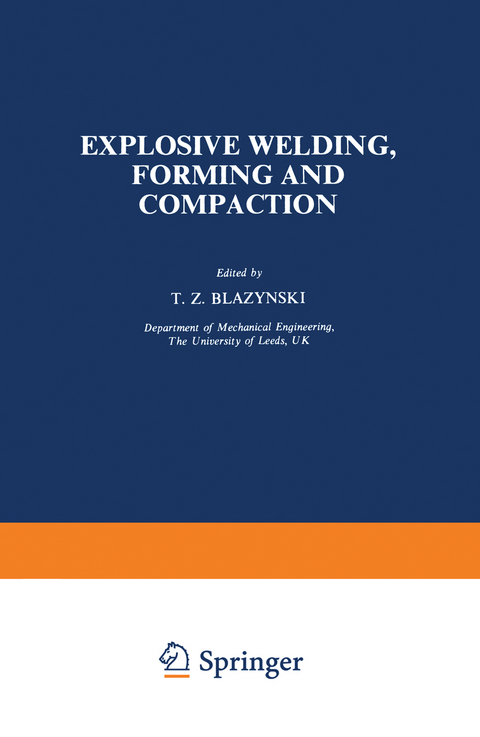
Explosive Welding, Forming and Compaction
Springer (Verlag)
9789401197533 (ISBN)
1. Introduction to High-energy-rate Metalworking.- 1.1. Background.- 1.2. High-energy-rate Processes.- 1.3. Development of the Field.- 1.4. Continued development of the field.- References.- 2. Propagation of Stress Waves in Metals.- 2.1. Dynamic Propagation of Deformation.- 2.2. Elastic Waves.- 2.3. Plastic Waves.- 2.4. Shock Waves.- 2.5. Defect Generation.- Acknowledgements.- References.- 3. Metallurgical Effects of Shock and Pressure Waves in Metals.- 3.1. Principal Features of High-strain-rate and Shock deformation in Metals.- 3.2. Permanent Changes: Residual Microstructure-Mechanical Property Relationships.- 3.3. Response of Metals to Thermomechanical Shock Treatment.- 3.4. Summary and Conclusions.- Acknowledgements.- References.- 4. High-rate straining and Mechanical Properties of Materials.- 4.1. Introduction.- 4.2. Testing Techniques at High Rates of Strain.- 4.3. Mechanical Properties of Materials at High Rates of Strain.- 4.4. Mechanical Equations of State at High Rates of Strain.- 4.5. Summary.- References.- 5. Basic Consideration for Commercial Processes.- 5.1. Explosive cladding.- 5.2. Design of Clad Assemblies.- 5.3. Assembly of Clads.- 5.4. Explosives.- 5.5. Double Sided Clads.- 5.6. Multilayer Clads.- 5.7. Post Cladding Operations.- 5.8. Destructive Testing.- 5.9. Tubular Components.- 5.10. Explosive Hardening.- 6. Mechanics of Explosive Welding.- 6.1. Introduction.- 6.2. The Mechanism of Explosive Welding.- 6.3. Parameters of the Explosive Welding Process.- 6.4. Interfacial Waves.- 6.5. Analysis of Flow in the Collision Region.- References.- 7. Explosive Welding in Planar Geometries.- 7.1. Introduction.- 7.2. Material Combinations and Flyer Thicknesses.- 7.3. Basic Welding Geometries.- 7.4. Selection of Bonding Parameters.- 7.5. Direct Measurement of Bonding Parameters.- 7.6. Miscellaneous Welding Geometries for Sheets and Plates.- 7.7. Welding of Foils.- 7.8. Applications.- 7.9. Conclusions.- Acknowledgements.- References.- 8. Welding of Tubular, Rod and Special Assemblies.- 8.1. Introduction.- 8.2. Explosive and Implosive Welding Systems and Bonding Parameters.- 8.3. Welding of Duplex and Triplex Cylinders.- 8.4. Tube-to-tubeplate Welding.- 8.5. Explosive Plugging of Tubes in Tubeplates.- 8.6. Multilayer Foil Reinforced Cylinders.- 8.7. Interface Wire Mesh Reinforcement.- 8.8. Transition Joints.- 8.9. Solid and Hollow Axisymmetric Components.- References.- 9. Explosive Forming.- 9.1. Introduction.- 9.2. Formability of Engineering Alloys.- 9.3. Mechanical Properties of Explosively formed Components.- 9.4. Air and Underwater Forming Systems.- 9.5. Die and Dieless Forming.- 9.6. Analysis of Final Shapes in Free-Forming.- 9.7. Parameters and Analysis of Die Design.- 9.8. Forming of Domes and of Elements of Spherical Vessels.- 9.9. Forming and Punching of Tubular Components.- 9.10. Miscellaneous Forming Operations.- 9.11. Conclusion.- References.- 10. Powder Compaction.- 10.1 Introduction.- 10.2 Dynamic Compressibility of Powders.- 10.3. Type of Shock Wave and Density Distribution.- 10.4. Temperature and Strain Rate Effects.- 10.5. Phase Transitions in Shock Loading Mixtures.- 10.6. General Mechanical Properties of Compacted Powders.- 10.7. X-ray and Other Methods of Evaluating Residual Stress Distribution.- 10.8. Basic Problems in Fabricating Semi-finished Parts.- 10.9. Static and Dynamic Compaction: A Comparison of Material Properties.- References.
| Zusatzinfo | 126 Illustrations, black and white |
|---|---|
| Verlagsort | Dordrecht |
| Sprache | englisch |
| Maße | 152 x 229 mm |
| Themenwelt | Naturwissenschaften ► Physik / Astronomie ► Allgemeines / Lexika |
| ISBN-13 | 9789401197533 / 9789401197533 |
| Zustand | Neuware |
| Informationen gemäß Produktsicherheitsverordnung (GPSR) | |
| Haben Sie eine Frage zum Produkt? |
aus dem Bereich


